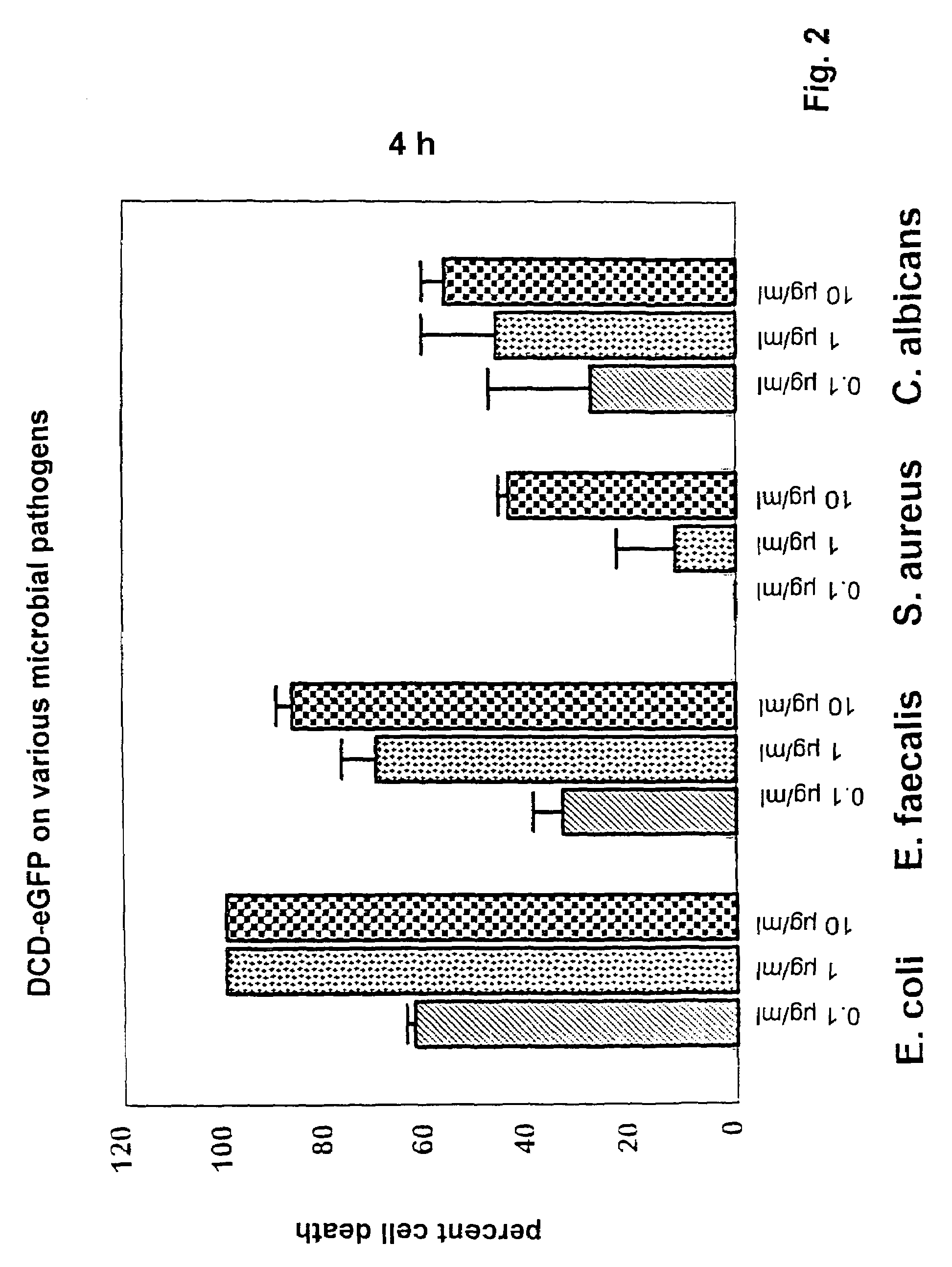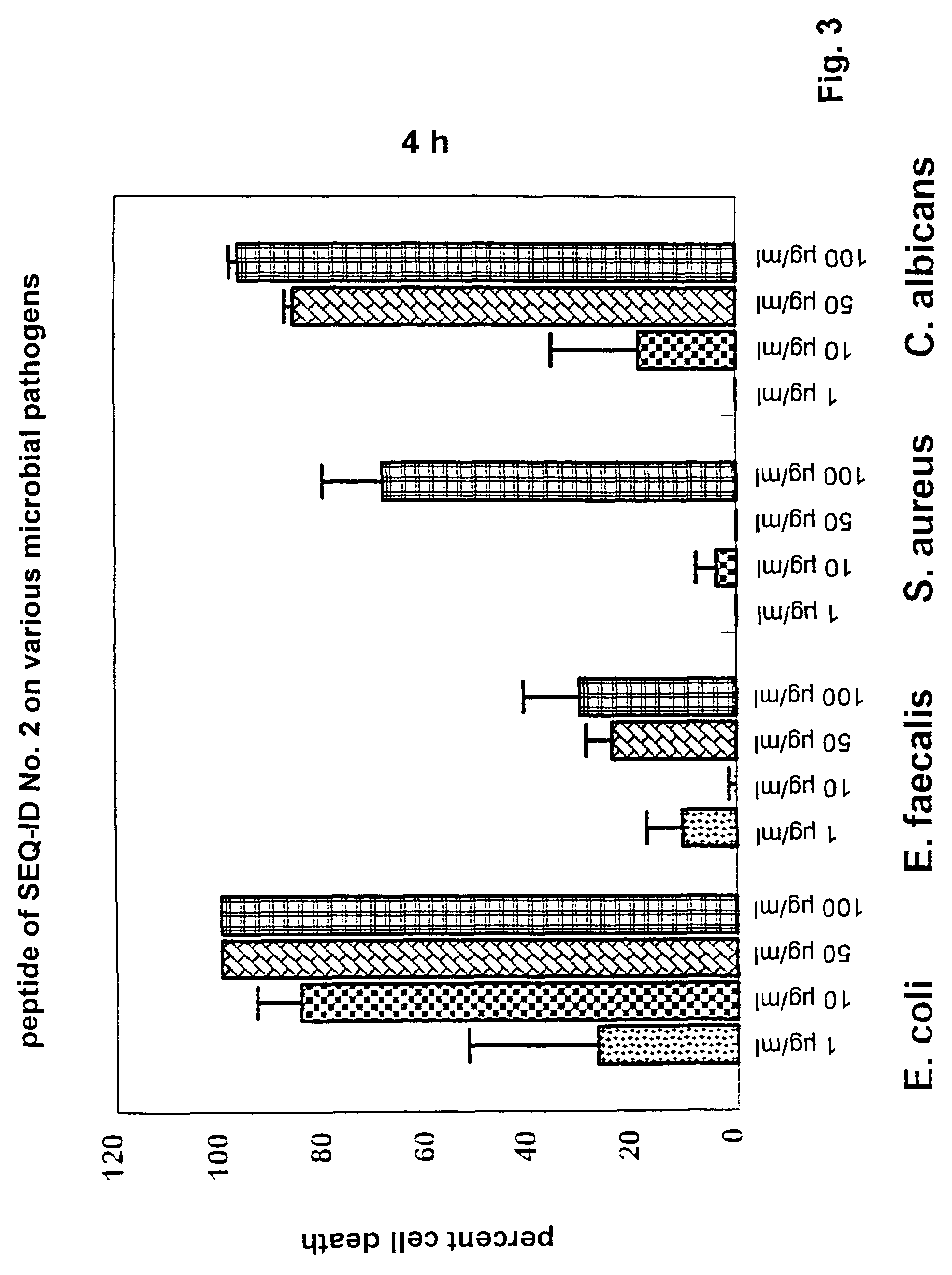Antimicrobially active peptide
a technology of peptides and active ingredients, applied in the field of antimicrobial activity active peptides, can solve the problems of increasing frequency, and ineffective control of pathogens
- Summary
- Abstract
- Description
- Claims
- Application Information
AI Technical Summary
Benefits of technology
Problems solved by technology
Method used
Image
Examples
example 1
Isolation of the DCD cDNA and Determination of the Genomic Sequence
[0051]In the screening of a subtractive cDNA library of primary melanoma tissue and benign melanocyte nevus tissue using cDNA arrays, a clone which was overexpressed in the nevus tissue compared with the melanoma tissue and which, at the time of isolation, had no sequence homology with a gene published in GenBank was isolated; Hipfel et al., “Specifically Regulated Genes in Malignant Melanoma Tissues Identified by Subtractive Hybridization”, British Journal of Cancer 82, 1149-1157 (2000). The clone referred to as clone 8 in the publication therein was subsequently called dermicidin (DCD).
[0052]The full length of the DCD cDNA was determined by sequencing overlapping PCR products, and it is 458 bp with an open reading frame of 330 bp, which codes for 110 amino acid residues. The gene consists of five exons and four introns and is expressed as a single transcript.
[0053]FIG. 1A indicates the genomic sequence of the DCD g...
example 2
Detection of DCD in Various Tissue Samples
[0055]The DCD expression profile was determined by testing by the dot-blot technique RNA from fifty different tissues and development stages, using labeled DCD cDNA as probe. No detectable signal was found in any of the fifty samples.
[0056]In order to analyze whether the DCD gene is expressed to only a very small extent in human tissue or human cell lines, an RT-PCR was carried out for the DCD gene (Clontech MTC Panels). It emerged that DCD is strongly expressed in human skin, human melanocytic nevus tissue and melanoma tissue, but that DCD is not expressed in the other sixteen human tissues analyzed or in fetal and various tumor tissues. In addition, no amplification products were found after an RT-PCR with forty cycles in different parts of the human digestive system and in various tumor cell lines either.
[0057]It can be inferred from these results that DCD expression is confined to cells in the skin.
[0058]The cell type which expresses the...
example 3
Construction, Expression and Characterization of a DCD-eGFP Fusion Protein
[0066]The complete DCD cDNA without stop codon was cloned in frame into the pEGFP vector (Clontech, Heidelberg) 5′ to the eGFP gene, thus generating a fusion gene called DCD-eGFP. The correct sequence was confirmed by sequence analysis.
[0067]SKMEL28 melanoma cells (PNAS 73, 3278-3282 (1976)) were transfected with 1-2 μg of DCD-eGFP or eGFP alone using Fugen (Roche, Mannheim) and cultivated in RPMI with 10% FCS.
[0068]After 48 hours, 500 μm / ml G418 (Calbiochem, Schwalbach) were added to the medium, and the amount of G418 was changed to 1 mg / ml after one week. The cells were kept in selection medium and cloned by limiting dilution. A stable clone from each transfection was used for further analysis. Cell lysates of the two clones (5−7×106 cells) were prepared by incubating the cells in 1.2 ml of lysis buffer (PBS with 0.5% Triton X-100, 5 mM EDTA, 0.1 mM PMSF, 10 μM pepstatin A, 10 μM leupeptin, 25 μg / ml aprotini...
PUM
| Property | Measurement | Unit |
|---|---|---|
| molecular weight | aaaaa | aaaaa |
| concentration | aaaaa | aaaaa |
| incubation time | aaaaa | aaaaa |
Abstract
Description
Claims
Application Information
 Login to View More
Login to View More - R&D
- Intellectual Property
- Life Sciences
- Materials
- Tech Scout
- Unparalleled Data Quality
- Higher Quality Content
- 60% Fewer Hallucinations
Browse by: Latest US Patents, China's latest patents, Technical Efficacy Thesaurus, Application Domain, Technology Topic, Popular Technical Reports.
© 2025 PatSnap. All rights reserved.Legal|Privacy policy|Modern Slavery Act Transparency Statement|Sitemap|About US| Contact US: help@patsnap.com



